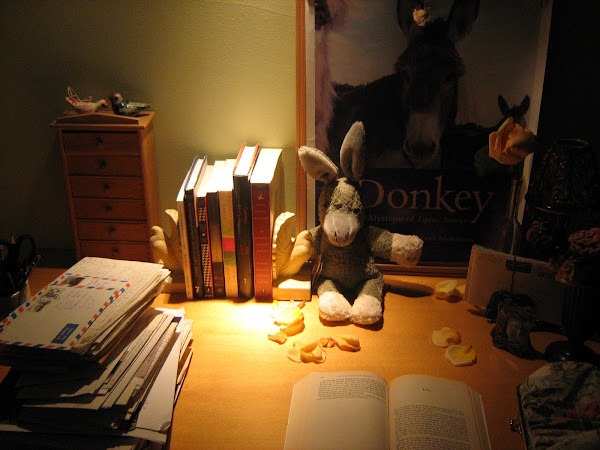I ordered this Ramadan lantern from Egypt. Ramadan traditions vary around the world, but Egypt has a long-standing tradition of Ramadan lanterns. Children insert candles into small ones and then walk along the streets at sunset, singing a song thousands of years old (no one is quite sure what it means anymore) and receiving gifts of fruit and nuts.
Ramadan is the ninth month of the Islamic calendar, a lunar calendar, like most ancient religious calendars. The Qur’an was revealed to Muhammad during the month of Ramadan in the early 7th century, and the Qur’an states that fasting is prescribed for Muslims, as it was for those who came before (meaning the Jews). Islam has always accepted Judaism and Christianity as part of its own tradition, with some differences, of course. When Muhammad first started preaching his religion, he urged his followers to fast on Yom Kippur in solidarity with the Jews.
For the 29 or 30 days of Ramadan, Muslims fast from dawn to sunset, refraining from food, water, sex, and smoking. After sunset (and until dawn, when the fast starts again), normal practices are allowed again. Fasting is required only for healthy adults; those who are elderly, traveling, sick, pregnant, menstruating, or nursing should not fast. Fasting is meant to be difficult, but not dangerous. Any danger to health excuses the fast.
Muslims fast for several reasons. There’s long been an acknowledged connection between fasting and piety, and most religions observe some type of fasting. Fasting allows for leaving bodily concerns behind so that we can concentrate on higher and more spiritual goals, to reflect on and give thanks to God. (And okay, I admit it, I do always secretly hope for weight loss, but that’s incidental.)
In addition, fasting forces compassion upon us. Every hour, about 1,000 people worldwide die of hunger, hunger-related causes, and lack of drinkable water. We all know about world hunger. But nothing brings it home so personally as going without food or water yourself. I think many people would be surprised to know that what’s debilitating about fasting is not hunger pains and growling stomachs – rather, it’s the fatigue, apathy, lethargy, and inability to think clearly that is so dramatically difficult. And that’s despite knowing that we can eat and drink at sunset – a very lenient fast indeed, when compared to the starving people who don’t have an end in sight. No one takes food or water for granted during Ramadan.
Most people wake up before dawn to eat a small meal before the fast starts; I don’t, as I’d rather forgo eating than wake up at 4 am. It’s traditional to break the fast with water and dates. Muslims must break the fast immediately upon sunset, as extending the fast is not allowed, both for health reasons and for discouraging posturing (“I can fast longer than you can!”). During Ramadan, Muslims pray additional nighttime prayers, as well.
The day after Ramadan (the first day of the next lunar month) is called Eid ul-Fitr, or “Festival of the Fast-Breaking.” In many countries, feasting and celebrations take place over three days’ time. In the United States, Eid was always a disappointing holiday for me as a child; though my parents tried to make it festive, nothing we did could approach the glamorous lights and decorations and holiday music that annually heralded the arrival of Christmas. Moreover, many adults didn’t get the day off, and most Muslim families lived far enough away from each other that holiday gatherings were logistically difficult.
Still, Eid meant that we children received traditional new clothes with the reminder to wear something old underneath to keep us humble. We got presents or money, as well. And of course, everyone ate! Every culture has its traditional Eid food. Being Indian-Pakistani, my mother made kababs, biriyani (chicken in spicy rice), and sheer khurma (a milk pudding with pistachios, cardamom, and vermicelli noodles).
My daughter's palm, decorated with henna for Eid. The
stain washes away in about two weeks.
When my kids were toddlers, I decided that I wanted to make Eid more festive, so we began to throw a holiday dinner party for seventy people. We invited all our friends, whether they were Muslim or not, and distributed presents to the kids, decorated our guests’ hands with henna, and played loud Bollywood music. We greeted our guests by sprinkling rose water on their shoulders and offering them scent for their wrists. Eid parties are always formal in India and Pakistan, so we all wore formal clothes, even my husband (though not without much groaning and rolling of eyes).
During the last few years, some Muslim mosques have organized Eid festivals or fairs, featuring games and for children and various vendors selling food and textiles and clothing. Eid ul-Fitr is the most prominent holiday for most Muslims. After accomplishing a month of fasting, a celebration is in order!
Me, with guests, at our Eid party. My collection of lanterns sits on the table, and the banner reads "Eid Mubarak," or "Eid Congratulations."
The traditional Muslim greeting is also used as a farewell (like "aloha"), and is As-salamu Alaykum, which means “peace be upon you” in Arabic. The response is wa-alaykum salam, or “upon you be peace.”
So that is my Ramadan wish to everyone this year and every year: may we continue to build multicultural bridges and may we have peace upon us, whoever we are, whatever our background.



What a beautiful lantern!
ReplyDeleteI love that, perfect for this coming ramadan.
My best ramadan wishes to you.
Ramadan Kareem!